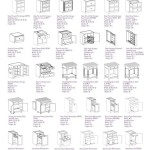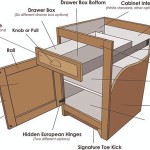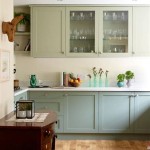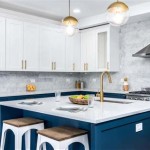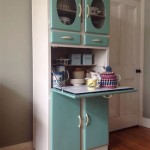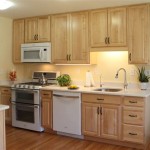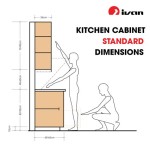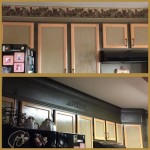Ideas On Painting Kitchen Cabinets
Painting kitchen cabinets is a transformative and cost-effective way to refresh the heart of the home. It offers an opportunity to modernize the aesthetic, correct outdated color schemes, and even increase a home's value. However, achieving a professional-looking finish requires careful planning, preparation, and execution. Several factors contribute to the success of a cabinet painting project, including selecting the right paint type, preparing the surfaces meticulously, and employing appropriate painting techniques. The following provides insights and considerations for successfully painting kitchen cabinets.
Selecting the Right Paint and Primer
The choice of paint significantly impacts the durability and appearance of the finished cabinets. Acrylic latex paint is a popular option due to its ease of application, low odor, and water-based cleanup. It provides good adhesion and is available in a wide range of colors and sheens. For cabinets that experience frequent use and cleaning, a higher sheen level, such as semi-gloss or gloss, is recommended. These sheens are more resistant to stains and easier to wipe clean.
Alkyd paint, also known as oil-based paint, offers superior durability and a smoother, more professional finish than acrylic latex. However, alkyd paints have a stronger odor, require mineral spirits for cleanup, and take longer to dry. They also tend to yellow over time, especially in areas with limited sunlight. While alkyd paint was once the standard for cabinet painting, advancements in acrylic technology have made acrylic latex paints a viable and often preferred alternative for many homeowners.
Specialty cabinet paints, often acrylic-urethane hybrids, are formulated specifically for cabinets and offer a balance of durability, smooth finish, and ease of use. These paints are designed to resist chipping, scratching, and staining, making them an excellent choice for high-traffic areas like kitchens. They also tend to self-level, minimizing brush strokes and creating a more uniform appearance.
Primer serves as a crucial foundation for the paint, promoting adhesion and preventing the existing finish from bleeding through. A high-quality primer will also seal the surface, creating a uniform base for the paint and improving its coverage. Oil-based primers are effective at blocking stains and tannins from wood, but they require mineral spirits for cleanup. Latex primers are easier to work with and clean up, and they are generally suitable for cabinets that have been previously painted with latex paint. Shellac-based primers are known for their excellent adhesion and stain-blocking properties, and they are a good choice for cabinets with a particularly glossy or difficult-to-adhere-to finish.
When selecting paint and primer, consider the existing finish on the cabinets, the desired sheen level, and the overall aesthetic goals. It is generally recommended to use the same type of primer and paint (e.g., latex primer with latex paint) to ensure compatibility and optimal adhesion.
Meticulous Preparation is Key
Proper preparation is arguably the most important step in painting kitchen cabinets. A poorly prepared surface will result in a substandard finish, regardless of the quality of the paint. The preparation process involves several crucial steps, including removing hardware, cleaning the cabinets, sanding the surfaces, and applying primer.
Begin by removing all cabinet doors and drawers. Label each door and drawer with a corresponding number or letter to ensure proper reinstallation. Remove all hardware, such as knobs, pulls, and hinges. Store the hardware in a safe place to prevent loss or damage. Cleaning the cabinets is essential for removing grease, dirt, and grime that can prevent the paint from adhering properly. Use a degreasing cleaner specifically designed for kitchen cabinets. Wipe down all surfaces thoroughly and allow them to dry completely.
Sanding the cabinet surfaces creates a slightly rough texture that allows the primer to grip the surface more effectively. Use a medium-grit sandpaper (120-150 grit) to lightly sand all surfaces. Focus on removing any existing gloss or imperfections. After sanding, wipe down the cabinets with a tack cloth to remove any sanding dust. This step is critical for achieving a smooth, even finish. For cabinets with a particularly glossy or durable finish, consider using a liquid deglosser in addition to sanding. A deglosser chemically etches the surface, improving adhesion.
Once the cabinets are clean and sanded, apply a coat of primer. Use a brush or roller to apply the primer evenly, paying attention to corners and edges. Allow the primer to dry completely according to the manufacturer's instructions. After the primer has dried, lightly sand the surface again with a fine-grit sandpaper (220 grit) to smooth out any imperfections. Wipe down the cabinets with a tack cloth to remove any sanding dust.
Filling any holes, cracks, or imperfections in the cabinet surfaces with wood filler is important for achieving a professional-looking finish. Apply the wood filler according to the manufacturer's instructions and allow it to dry completely. Sand the filled areas smooth with fine-grit sandpaper and wipe down the cabinets with a tack cloth.
Masking off surrounding surfaces, such as countertops, walls, and appliances, is necessary to protect them from paint splatters. Use painter's tape to create clean, crisp lines. Cover large areas with drop cloths to protect the floors and other surfaces.
Applying Paint and Achieving a Professional Finish
With the cabinets properly prepared, the painting process can begin. The key to achieving a professional finish lies in applying thin, even coats of paint. Avoid applying too much paint at once, as this can lead to drips, runs, and an uneven texture. Use a high-quality brush or roller specifically designed for painting cabinets. A small, angled brush is ideal for painting corners and edges, while a foam roller provides a smooth, even finish on larger surfaces.
Apply the first coat of paint in thin, even strokes, following the grain of the wood. Work in small sections to ensure that the paint is applied uniformly. Allow the first coat to dry completely according to the manufacturer's instructions. Once the first coat is dry, lightly sand the surface with fine-grit sandpaper to smooth out any imperfections. Wipe down the cabinets with a tack cloth to remove any sanding dust.
Apply a second coat of paint using the same technique as the first coat. A second coat is typically necessary to achieve full coverage and a uniform color. Allow the second coat to dry completely according to the manufacturer's instructions. For a particularly durable finish, consider applying a third coat of paint. However, be careful not to apply too many coats, as this can result in a thick, uneven finish.
For those seeking an ultra-smooth, factory-like finish, consider using a paint sprayer. A paint sprayer atomizes the paint, creating a fine mist that is applied evenly to the surface. This technique requires some practice and skill, but it can produce exceptional results. When using a paint sprayer, be sure to thin the paint according to the manufacturer's instructions. Also, wear a respirator to protect yourself from inhaling paint fumes.
Sand lightly between coats of paint. This step is crucial for removing any imperfections and creating a smooth, even surface for the next coat. Use fine-grit sandpaper (220 grit or higher) and apply light pressure. Be careful not to sand through the paint to the primer or bare wood.
After the final coat of paint has dried completely, remove the painter's tape carefully. Score the edge of the tape with a utility knife before peeling it off to prevent the paint from chipping. Reinstall the hardware and rehang the cabinet doors and drawers. Ensure that all doors and drawers open and close smoothly. Make any necessary adjustments to the hinges or drawer slides.
Allow the paint to fully cure before using the cabinets. Curing is the process by which the paint hardens and becomes more durable. The amount of time required for curing varies depending on the type of paint used, but it typically takes several days to weeks. During this time, avoid placing heavy objects on the cabinets or exposing them to excessive moisture.
Clean the painted cabinets with a mild soap and water solution. Avoid using abrasive cleaners or scouring pads, as these can damage the finish. Wipe down the cabinets regularly to remove dirt and grime. With proper care and maintenance, a well-painted set of kitchen cabinets can last for many years.
:strip_icc()/painted-kitchen-cabinet-ideas-20-becca-interiors-southampton-0b04a571a07649deb33edae1e89d9c41.jpeg?strip=all)
29 Painted Kitchen Cabinet Ideas You Can Easily Copy

How To Paint Kitchen Cabinets
:max_bytes(150000):strip_icc()/DearLillieCabinets-5c64643b46e0fb0001f090ca.jpg?strip=all)
30 Painted Kitchen Cabinet Ideas

Painted Kitchen Cabinet Ideas Architectural Digest

20 Diy Painted Kichen Cabinet Ideas A Cultivated Nest

How To Paint Kitchen Cabinets In 7 Simple Steps

Kitchen Cabinet Paint Ideas

15 Best Painted Kitchen Cabinets Ideas For Transforming Your With Color

How To Choose Kitchen Cabinet Paint Colors

20 Diy Painted Kichen Cabinet Ideas A Cultivated Nest
Related Posts

